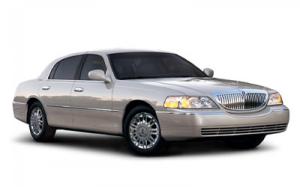Tuesday, August 13, 2013
2006 Lincoln Town Car Reviews
 This 2003 review is representative of model years 2003 to 2006.
This 2003 review is representative of model years 2003 to 2006.Below is a full, detailed 2006 Lincoln Town Car review and road test from new car Test Drive. A full evaluation of price, equipment, the driving experience, and specs are all here in a structured, easy-to-navigate format from journalists with limitless experience.
The big 2003 Lincoln Town Car is reminiscent of grand 1930s luxury cars such as the large Duesenbergs, Packards, Cadillacs and Lincolns.
Such rear-drive cars were breathtaking, especially if they had custom bodies. Even today, a 1936 Packard Twelve with a custom body by Fernandez & Darrin of Paris can stop people in their tracks.
However, Duesenbergs and Packards are long gone, and General Motors and DaimlerChrysler have abandoned the V8, rear-drive luxury sedan market—at least temporarily.
That makes the Lincoln Town Car really stand out. It has some of the visual impact of the top 1930s luxury cars because of its slick styling and large size. In fact, its the only big rear-drive V8 American luxury yacht left.
The latest version of the Town Car has gone on sale this summer as a strategically improved early 2003 model, with base prices ranging from $40,270 to $50,700.
Big car with big trunk
"Town Car customers can buy whatever they please, and their priorities are room, ride, comfort and safety," said Rick Brisson, Town Car brand manager. Indeed, the more than 17.5-foot-long Town Car is all about room. It already had the largest trunk in its class— perfect for suitcases and golf bags of all sizes. You dont have to organize them or sort them; they seem to fit back there without fuss.
Now, access to the Town Cars 21-cubic-foot trunk is improved, thanks to a wider trunk opening in the 2003 and the fact the mini-spare tire that used to intrude from a back shelf in the trunk is repositioned.
Inside, the Town Cars 45.8 inches of legroom in the front seat and minimum 41.1 inches in the back seat— 46.96 inches in the Town Car long-wheelbase trims— are noteworthy. In contrast, the Cadillac DeVille has 42.4 inches of front legroom and 43.2 inches in the back, according to Cadillac.
Likewise, the Town Cars front-seat hip room of 57.3 inches surpasses that of the DeVille and Lexus LS 430.
Limo-Style Rear Room
Most of the extra space of the longer-wheelbase trims is devoted to more rear-seat room. In fact, the long-wheelbase trims have more back seat legroom than any regular production car. However, the standard-length Town Car has plenty of rear-seat room.
One might think that the big, heavy Town Car would be clumsy, but the 2002 model was generally good in that regard and the 2003 model is significantly better.
Same engine, more power
The 2003 Town Car has the 4.6-liter, single overhead cam V8 that was in the predecessor.
But it makes more power now — 239 horsepower vs. 220 in the 2002 Town Car. Torque is up 22 lb-ft to 287 at 4100 rpm.
Its more than adequate to get the new Town Car up and moving quickly. I launched out of a parking lot and into traffic, yet easily managed to keep ahead of the oncoming cars, for example.
Shifts from the four-speed automatic transmission are smooth most of the time. There was a sharp jerk when the accelerator was depressed hard for a bit, as if the driver wanted quick acceleration, then released suddenly.
But despite the increased engine power, I didnt hear a lot of engine noise while inside the Town Car. The exception was when I had the pedal to the metal. Then, the deep sounds of a V8 at work would come through. Theyre newly tuned for a more pleasant sound this year, too. Fuel economy isnt bad for a car this big that can carry up to six passengers. The 2003 Town Car, which comes with a four-speed automatic transmission, is rated at 17 miles a gallon in the city and 25 mpg on the highway.
Improved Steering
The stiffer frame helps handling. So does the new rack-and-pinion steering, which replaces the older models less precise recirculating ball steering gear. Steering effort is low at parking speeds and rises progressively as speed goes up.
The front suspension has a more robust design with such items as upgraded shock absorbers to improve handling.
A revised rear suspension also allows better handling and reduces transmission of road impacts into the cars structure. That suspension has a stabilizer bar, and load-leveling air springs maintain a constant ride height, regardless of vehicle load.
There is a more powerful 4-wheel anti-lock brake system with a new booster that provides a "panic assist" during fast stops.

Pros:
A return to more formal styling
Suspension improvements bring better handling
Oh-so-roomy back seat, especially in L trims
Cons:
Still some floaty sensations
No head restraint for middle person in back
Some features not offered